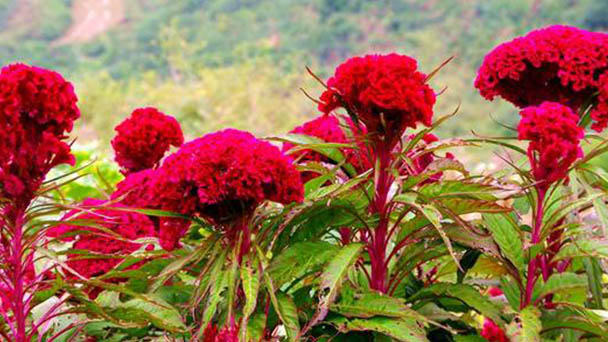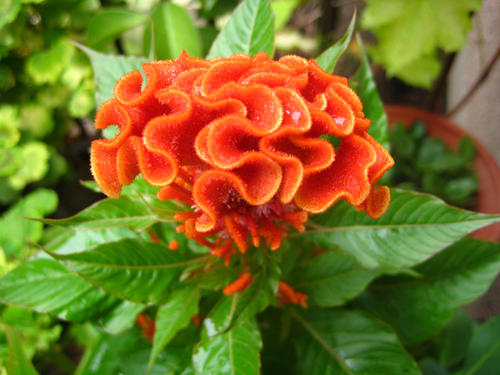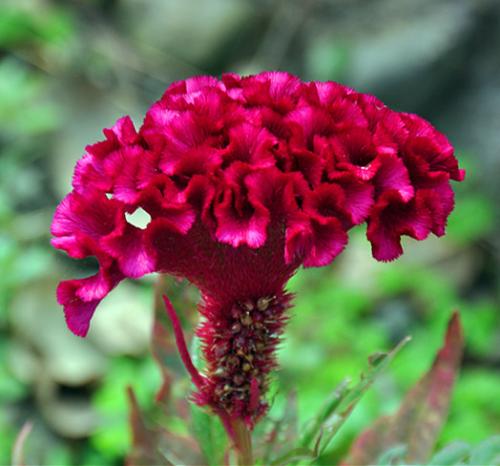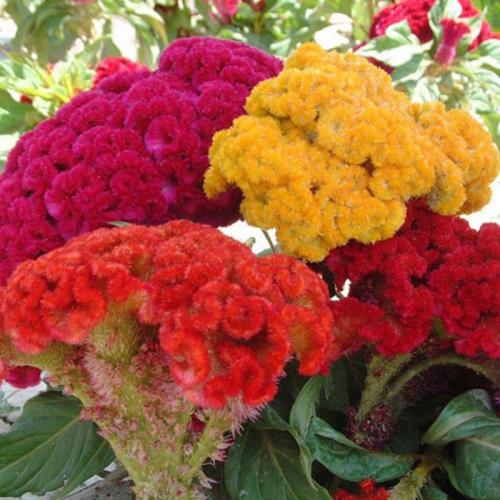Cockscomb profile
Written by Maggie
Nov 01 2021

Celosia cristata, the scientific name Celosia cristata, is native to Africa, tropical America and India. Cockscomb is an annual herb. It likes sunny, hot and humid, frost - resistant, not tolerant to barren, like loose fertile and well drained soil. It is widely cultivated all over the world.
Cockscomb picture

Cockscomb characteristics
Cockscomb flower is an annual herb, plant height 40-100 cm, stem erect stout, alternate leaves, long oval-shaped or oval-shaped lanceolate, spikes of meat terminal, fan-shaped, kidney shaped, flat spherical, such as natural flowering summer, autumn to frost's descent. It is commonly used for seed reproduction, growing period like high temperature, full light and dry air environment, drought tolerance is not cold, strong reproductive ability. In autumn, when the flowers are in full bloom, they are collected and dried. Leaves are ovate-lanceolate to lanceolate, entirely. Inflorescences are terminal and axillary, flattened comb - shaped. Flowers are white, pale yellow, golden, pale red, fiery red, purplish red, brown red, orange red and other colors.Utricle ovate, seeds glossy black.
Cockscomb stems are red or bluish white; Leaves are alternate with stalks, leaves of deep red, emerald green, yellow green, red green and other colors; Flowers are clustered at the top, shaped like a comb, flat and soft, grow on the plant in the shape of an inverted broom. Color is also rich and colorful, purple, orange yellow, white, red and yellow mixed with other colors. Seeds are small, purplish black, hidden in corolla tomentose. Cockscomb plants are tall, medium, short three types, short only 30 cm tall, high up to 2 meters.
Cockscomb has spikes, much flat and thick, coronal in shape. It is 8 ~ 25cm long, 5 ~ 20cm wide, with a maximum diameter of 40cm. Upper margin is broad, ruffled, densely linear scales, lower end tapering, often remaining stems flattened. The surface is red, fuchsia or yellow-white; Many florets are densely below middle, bracts and perianth of each flower membranous. The fruit is cracked and the seeds are oblate, kidney - shaped, black and shiny. It is light and flexible. Cockscomb has no smell, and light taste.
Cockscomb has a longer blooming period and can bloom from July to December.
Cockscomb Ecological habits:
Cockscomb likes warm and dry climates, afraid of drought, like sunshine, can not bear waterlogging, but if the soil requirements are not strict, the general soil garden can be planted, which is a new way to develop the current garden economy.
Cockscomb Cultivation and Maintenance Techniques:
Climate, soil
Cockscomb prefers a warm climate. The soil requirements are not strict, but it is better to cultivate with sand with good drainage.
Planting
The seeds propagate. General direct seeding can also be transplanted. During the direct seeding, 5-6 pieces of seeds should be used per acre, mixed with fire ashes mixed with human and animal dung water, and dug holes about 30cm apart and 3cm deep in each row on the furrows. The holes should be flat at the bottom. Human and animal dung water should be applied first, and then the seed ashes should be distributed evenly.

Field management
When the seedling height was 7-10cm, the seedlings were evenly and replenished, and 4-5 strong seedlings were left in each hole. Weeding and topdressing were carried out at the first time after even acre, and the second time in May.
Harvesting and processing
Generally before and after the white dew, the seeds gradually black and mature, can be timely cut off the flower moss, air drying place ventilation, flowers and seeds separate management, respectively into medicine, generally per acre yield seed 300 pounds, 1000 pounds or so. Flowers in the sun to go out early and come back late, do not make night dew, so as not to deteriorate and reduce the drug effect.
Main value of Cockscomb
Ornamental effect
Cockscomb flower has the reputation of being "the bird of flowers" and is one of the garden's famous open herbaceous flowers.
Cockscomb is a variety of species, plants are tall, medium, short three types, there are many shapes, such as crownlike, torch-like, velvet ball, feather, fan, etc..
Cockscomb is rich in colors, such as bright red, orange yellow, dark red, purple, white, red and yellow. Leaf color has deep red, emerald green, yellow green, red green to wait extremely good-looking, become the flowerbed that autumn uses commonly with flowers.
Adornment effect
Cockscomb can also be used as a good cut flower material, cutting the vase can keep more than 10 days. Cockscomb can also be dried flowers, durable and not withered.
Purification effect
Cockscomb flower can also purify the air and have good resistance to sulfur dioxide and hydrogen chloride, which can play a multiple role in greening, beautifying and purifying the environment.
Cockscomb is suitable as a green plant in the factory and can be regarded as a public ornamental flower against pollution.
Drug
Cockscomb is sweet and cool.
The flowers contain protein, fat, folic acid, pantothenic acid, vitamin B1, B2, B4, B12, C, D, E, K and other vitamins, as well as kaaningin, amaranth, pininol, potassium nitrate, 21 amino acids, 13 trace elements and more than 51 natural and enzyme coenzymes. The value of the medicine is very high.
The protein content of Cockscomb seeds is up to 73%, which can supplement the insufficient food content. Cockscomb seeds have the function of cold blood and hemostasis, attending to intestinal wind blood, red blood, dysentery, leakage, under, dengzhewo and other diseases.
Cockscomb vaccine can also be used as medicine for hemorrhoids, dysentery, vomiting blood, epistasis, blood collapse, urticaria and other conditions.

Read Next:
Celosia Plant (Cockscomb Flower) Grow & Care Guide
Latest Updated
- Benefits of Bugleweed - 7 Science-backed Health Benefits
- Bugleweed Dangers & Side Effects - Is It Poisonous?
- How to Plant Evergreen Trees - What You Should Know
- When to Plant Evergreens - Grow Guide for Evergreen Trees
- 12 Wonderful Evergreen Shrubs for Your Garden
- 12 Popular Evergreen Plants with Pictures for Beginners
- When And How To Prune A Lilac Bush Like a Pro
- How to Grow & Care for Lilac Vine (Hardenbergia Violacea)
- Japanese Lilac Tree (Syringa Reticulata) Care & Propagation Guide
- Shumard Oak Pros and Cons - What to Know
Popular Articles
- Winter maintenance of Antirrhinum Majus
- How to Grow Terminalia Mantaly Tree
- How to Grow and Care for Crossostephium Chinense
- How to grow Antirrhinum Majus in spring
- Peristeria Elata (Dove Orchid) Profile: Info & Care Guide
- Underwatered Snake Plant (Sansevieria Trifasciata) - Signs And How To Fix
- How to Care for Brazilian Jasmine Plant (Mandevilla Sanderi)
- How to Grow & Care for Graptopetalum Purple Delight in Summer
- Rosa Chinensis (China Rose): Plant Growing & Care Tips
- How to Care for Baby Sun Rose (Aptenia Cordifolia)